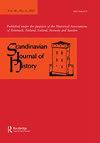转向内海?瑞典在独立前对波罗的海前苏联共和国的“软外交”
IF 0.8
3区 历史学
Q1 HISTORY
引用次数: 1
摘要
从20世纪80年代中期开始,苏联相对开放的时期为瑞典与邻近的波罗的海苏联共和国建立联系提供了机会。双方的政治局势不允许建立任何直接的外交关系,必须极为谨慎地作出一切努力。虽然这些倡议起初并不大,甚至在方案上也是如此,但它们有助于与波罗的海各共和国的独立运动建立联系。除了瑞典外交部(MFA)在列宁格勒的当地领事分支机构(通常没有斯德哥尔摩的明确指示)之外,瑞典政府更倾向于通过其主要的文化和公共外交机构——瑞典研究所(SI)——与波罗的海共和国进行首次接触,该机构后来被瑞典国际开发署(SIDA)取代。在他们的低调中,这些活动可以被分析为“软外交”的早期例子,这是后来波罗的海-北欧“新地区主义”的特征。本文利用国家安全局、瑞典外交部(MFA)的档案资料和对主要参与者的采访,展示了在波罗的海东部地区发展的相当不确定的情况下,瑞典外交如何探索瑞典与波罗的海共和国的联系。本文章由计算机程序翻译,如有差异,请以英文原文为准。
Turning towards the inland sea? Swedish ’soft diplomacy‘ towards the Baltic Soviet republics before independence
ABSTRACT The period of relative openness in the Soviet Union from the mid 1980s provided an opportunity for Sweden to establish contacts with the neighbouring Baltic Soviet republics. The political situation on both sides did not allow any direct diplomatic relations, and all endeavours had to be taken with utmost care. While modest at first, even programmatically so, these initiatives served to establish links with the independence movements in the Baltic republics. Besides the Local consular branch of the Swedish Ministry of Foreign Affairs (MFA) in Leningrad, often acting without clear instructions from Stockholm, the Swedish government preferred to channel its first contacts with the Baltic republics through its primary institution for cultural and public diplomacy, the Swedish Institute (SI), later supplanted in this role by the Swedish International Development Authority (SIDA). In their low profile, these activities can be analysed as early examples of the ‘soft diplomacy’ which have characterized later Baltic-Nordic ‘new regionalism.’. Drawing upon archival materials of the SI, the Swedish Ministry of Foreign Affairs (MFA) and interviews with key actors, this article shows how Swedish outreach to the Baltic republics was probed by Swedish diplomacy under considerable uncertainty of the development in the Eastern Baltic Sea region.
求助全文
通过发布文献求助,成功后即可免费获取论文全文。
去求助
来源期刊

SCANDINAVIAN JOURNAL OF HISTORY
HISTORY-
CiteScore
1.10
自引率
20.00%
发文量
33
期刊介绍:
Scandinavian Journal of History presents articles on Scandinavian history and review essays surveying themes in recent Scandinavian historical research. It concentrates on perspectives of national historical particularities and important long-term and short-term developments. The editorial policy gives particular priority to Scandinavian topics and to efforts of placing Scandinavian developments into a larger context. Studies explicitly comparing Scandinavian processes and phenomena to those in other parts of the world are therefore regarded as particularly important. In addition to publishing articles and review essays, the journal includes short book reviews. Review essay proposals and polemical communications are welcomed.
 求助内容:
求助内容: 应助结果提醒方式:
应助结果提醒方式:


